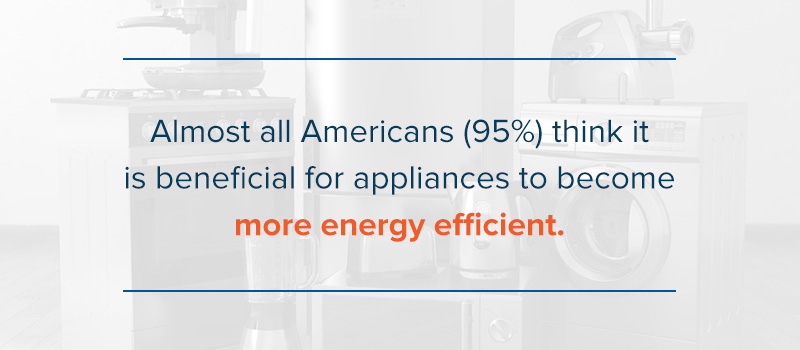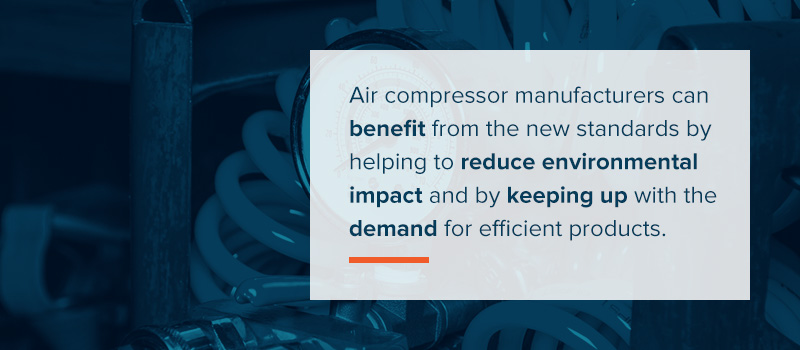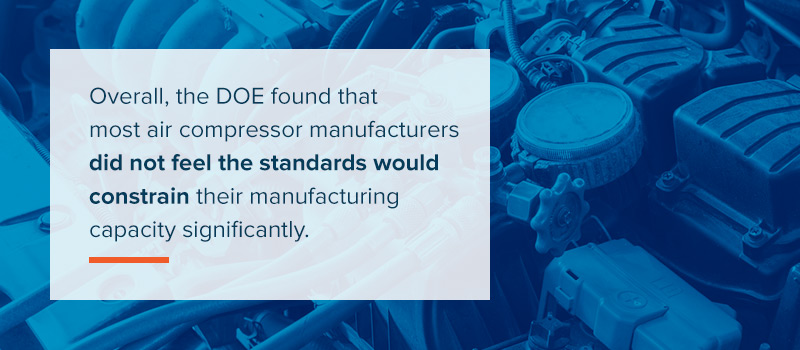Chapter 3: How Do the DOE Standards Impact the Air Compressor Industry?
The department’s energy conservation standards impact consumers and air compressor manufacturers in different ways. First, consumers want efficient appliances, including air compressors. This means that most consumers who buy compressors, whether for residential or commercial purposes, strongly support the department’s standards. In 2011, the Consumer Federation of America led a nationwide survey to learn about consumer knowledge and attitudes towards appliance energy efficiency. The survey revealed the following:
- Almost all Americans, or 95 percent, think it is beneficial for appliances to become more energy efficient.

- Ninety-six percent of Americans feel that improved energy efficiency is important for personal finances.
- The majority favor improved energy efficiency even if the appliances cost more to purchase than less-efficient appliances.
- Seventy-two percent of Americans support the government setting minimum energy efficiency standards.
- Survey respondents who are more aware of current energy standards are more likely to support them.
As this survey illustrates, the majority of Americans support energy efficiency standards and are willing to pay more for efficient appliances. They understand that they’ll save more money in the long run by using efficient products, and they are eager to support a healthier environment. As a result of new energy efficiency standards, consumers can rest assured they are getting quality, energy-saving products. Likewise, large companies who use air compressors to power much of their equipment and tools will benefit from substantial energy savings.
Air compressor manufacturers are responsible for delivering efficient products that meet the new standards. For smaller manufacturers, the standards may present certain challenges. However, air compressor manufacturers can also benefit from the new standards by helping to reduce the environmental impact and by keeping up with the demand for efficient products. In this chapter, we’ll look at how these standards benefit consumers and the environment, and the impact they have on air compressor manufacturers.
Benefits of DOE Air Compressor Standards
The new air compressor standards would make a significant impact on the environment and on the finances of industries who rely on compressed air as their “fourth utility.” According to the department, their standards would:
- Save 0.16 quadrillion BTUs over 30 years
- Result in estimated emission reductions of 6.5 thousand tons of sulfur dioxide, 8.2 million metric tons of carbon dioxide, 11.0 tons of nitrogen oxides, 40.8 thousand tons of methane, 0.1 thousand tons of nitrous oxide and 0.02 ton of mercury
- Result in $28.1 million in reduced equipment operating costs per year
Also according to the department, the life-cycle cost (LCC) savings are positive for all air compressor equipment classes covered by the standards, and the payback period (PBP) is less than the average lifetime of the covered air compressors.
Benefits of Efficient Equipment for Consumers
Generally, energy efficiency standards affect consumers by increasing purchase prices and decreasing annual operating costs. In other words, consumers will pay more for efficient equipment but save more in utility bills. However, air compressor equipment only accounts for just over 10 percent of the cost of producing compressed air. The cost to operate an air compressor is far higher than the cost to purchase one.
Whether you use an air compressor at home or in a facility, you will experience the impact of these standards on your utility bills. About 70 percent of all manufacturers have a compressed air system, so business owners will especially feel the effects of the energy efficiency standards when it’s time to upgrade their equipment.
In general, energy-efficient appliances complete the same tasks as less efficient equipment faster and with less effort. This reduces energy consumption and ultimately leads to substantial savings. Here are all the benefits consumers can expect as a result of energy standards:
- Cost savings: Perhaps one of the greatest benefits for consumers is saving on utility bills. For example, standards from 1987 to 2013 are expected to save consumers over $950 billion on utility bills through 2020 and $1.7 trillion through 2030.
- Energy savings: EPCA requires the department to consider energy savings and economic justification of a standard. Therefore, consumers know for certain they are getting energy-saving appliances thanks to new energy conservation standards.
- Energy security: Efficient appliances and equipment help conserve energy which promotes higher levels of energy security. This means that consumers do not need to worry as much that energy will become unavailable.
- Emissions reductions: The standards will likely reduce emissions of air pollutants and greenhouse gases. The estimated monetary value of reduced emissions is in the millions.
- Innovation: Standards ensure customers are getting the newest technology rather than using outdated technology. The department evaluates potential standards that would not lessen the performance or use of considered products.
- Consistency: With energy efficiency standards in place, consumers can expect consistency in product performance. Some appliance manufacturers may go above and beyond the minimum requirements so consumers can enjoy maximum efficiency.
- Job creation: Standards create research, manufacturing and installation jobs. They reduce consumer utility bills which lead to increased spending in other parts of the economy. The Bureau of Labor Statistics (BLS) suggests that net national employment may increase due to shifts in consumer spending resulting from energy conservation standards. The American Council for an Energy-Efficient Economy (ACEEE) also estimates that jobs will increase by 2030 as a result of energy conservation standards.
Impact on of DEO Standards on Air Compressor Manufacturers
The department’s energy conservation standards will affect air compressor manufacturers differently than consumers. Many manufacturers have already adopted the standards. However, smaller businesses may find it more challenging to make changes to comply within the five-year time frame. Air compressor manufacturers can expect the following impacts resulting from the new standards.
1. Higher Manufacturing Costs
Manufacturing efficient appliances is typically more expensive than creating less efficient appliances. A large portion of the cost goes towards converting production facilities and equipment designs to meet efficiency standards. Product conversion costs include investments in research, development, testing, marketing and other expenses needed to make new designs compliant. Capital conversion costs include investments in properties and equipment needed to adopt a change in product design.
In the NOPR, the department states that on average, small businesses will incur $3.95 million to $5.15 million in conversion costs per company. Large businesses will incur $6.02 million to $7.85 million in conversion costs per company on average. Small businesses may be affected negatively because they do not have as much capital as large companies, and the standards will be more of a burden. Some small companies may leave the industry, or larger companies might acquire them. Since the NOPR, the department updated the small business analysis for the final rule.
Overall, the department found that most manufacturers did not feel the standards would constrain their manufacturing capacity significantly, and they would not have any trouble obtaining enough floor space, equipment and labor to complete redesigns within the compliance period.
2. Testing Costs
Testing four to five units using the NOPR system could cost up to $125,000 for a manufacturer. However, as we will discuss more in Chapter 4, revisions to the NOPR aim to reduce the testing burden for manufacturers.
3. May Affect Labor
There is the risk that the standards will decrease manufacturing jobs. However, producing more efficient compressors usually requires more labor so employment could also increase. Nevertheless, some companies may send production overseas to take advantage of lower labor costs and avoid conversion costs of domestic facilities.
4. The Impact Is Different for Packagers
Packagers are companies who assemble motors and other accessories with air-ends purchased from other companies to create a complete compressor. Original equipment manufacturers (OEMs), on the other hand, manufacture their own air-ends and assemble them with other components to form complete air compressors. OEMs are expected to incur significant redesign and conversion costs, while packagers are not.
Even so, the average packager facility will incur between $1.5 million and $2.2 million in engineering redesign costs. Industry testing is estimated to cost packagers $2.3 million.
Some manufacturers are frustrated and not sure how to design products when many standards are incomplete. They’ve expressed many concerns to the department about these standards. Nevertheless, other businesses have already embraced energy-efficient designs. Manufacturers can benefit from the standards because they facilitate market introduction of energy-efficient products.



